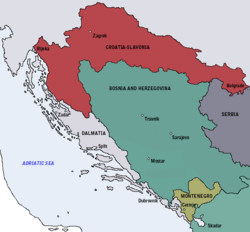Croatia-Slavonia
| Kingdom of Croatia-Slavonia | ||||||||||||
| Constituent kingdom within Austria-Hungary (part of the Lands of the Crown of St Stephen) |
||||||||||||
|
||||||||||||
|
||||||||||||
|
Map of the Kingdom of Croatia Slavonia (red) cca. 1885. The Kingdom was a part of Transleithanian Austria-Hungary, the Kingdom of Hungary (Lands of the Crown of St. Stephen). The rest of Austria-Hungary is in light grey.
|
||||||||||||
|
Croatia-Slavonia within Austria-Hungary (number 17)
|
||||||||||||
| Capital | Zagreb | |||||||||||
| Languages | Croatian | |||||||||||
| Religion | Roman Catholic | |||||||||||
| Government | Constitutional Monarchy | |||||||||||
| King | ||||||||||||
| • | 1868–1916 | Franz Joseph I | ||||||||||
| • | 1916–18 | Charles IV | ||||||||||
| Ban (Viceroy) | ||||||||||||
| • | 1868–71 | Levin Rauch (first) | ||||||||||
| • | 1917–18 | Antun Mihalović (last) | ||||||||||
| Legislature | Parliament | |||||||||||
| Historical era | New Imperialism / WWI | |||||||||||
| • | Compromise of 1867 | 30 March 1867 | ||||||||||
| • | Settlement of 1868 | 26 September 1868 | ||||||||||
| • | Independence | 29 October 1918 | ||||||||||
| Area | ||||||||||||
| • | 1910 | 42,541 km² (16,425 sq mi) | ||||||||||
| Population | ||||||||||||
| • | 1880 est. | 1,892,499 | ||||||||||
| • | 1910 est. | 2,621,954 | ||||||||||
| Density | 61.6 /km² (159.6 /sq mi) | |||||||||||
| Currency | ||||||||||||
|
||||||||||||
| Today part of |
|
|||||||||||
| Area source: Population source: | ||||||||||||
The Kingdom of Croatia-Slavonia (Croatian: Kraljevina Hrvatska i Slavonija; Hungarian: Horvát-Szlavón Királyság; German: Königreich Kroatien und Slawonien) was a nominally autonomous kingdom within the Austro-Hungarian Empire, created in 1868 by merging the kingdoms of Croatia and Slavonia following the Croatian–Hungarian Settlement. It was associated with the Hungarian Kingdom within the dual Austro-Hungarian state, being within the Lands of the Crown of St. Stephen or Transleithania. The kingdom was ruled by the Habsburg Emperor-King of Austria-Hungary (Kaiser und König) under his title as "King of Croatia and Slavonia". The King's appointed steward was the Ban of Croatia and Slavonia. Although it was under the suzerainty of the Crown of Saint Stephen, the Kingdom of Croatia and Slavonia kept a significant level of self-rule.
In 1918, the kingdom declared independence and reformed into the State of Slovenes, Croats and Serbs.
The kingdom used the formal title of the Triune Kingdom of Croatia, Slavonia, and Dalmatia, thereby pressing its claim on the Kingdom of Dalmatia, but Dalmatia was a Kronland within the imperial Austrian part of Austria-Hungary (also known as Cisleithania). The claim was, for most of the time, supported by the Hungarian government, which backed Croatia-Slavonia in an effort to increase its share of the dual state. The union between the two primarily Croatian lands of Austria-Hungary never took place, however. According to the Article 53 of the Croatian–Hungarian Agreement, governing Croatia's political status in the Hungarian-ruled part of Austria-Hungary, the ban's official title was "Ban of Kingdom of Dalmatia, Croatia and Slavonia". The laws passed in Croatia-Slavonia used the phrase "Kingdom of Dalmatia, Croatia and Slavonia".
...
Wikipedia




